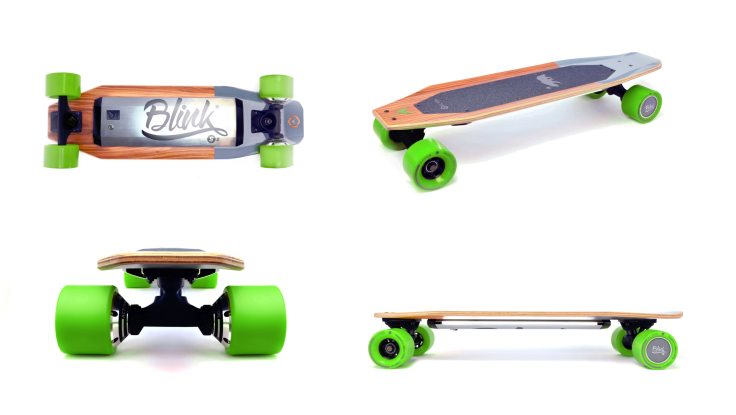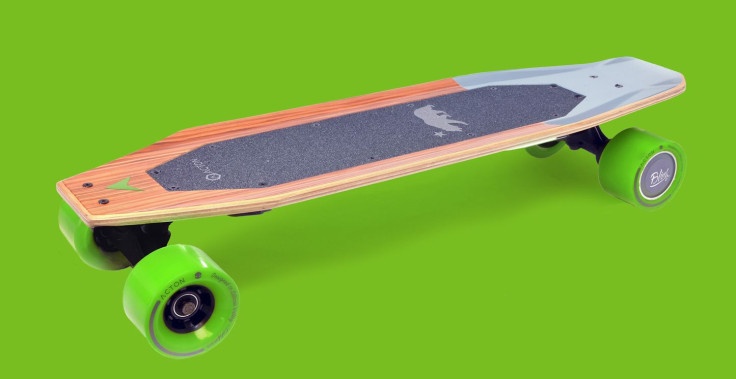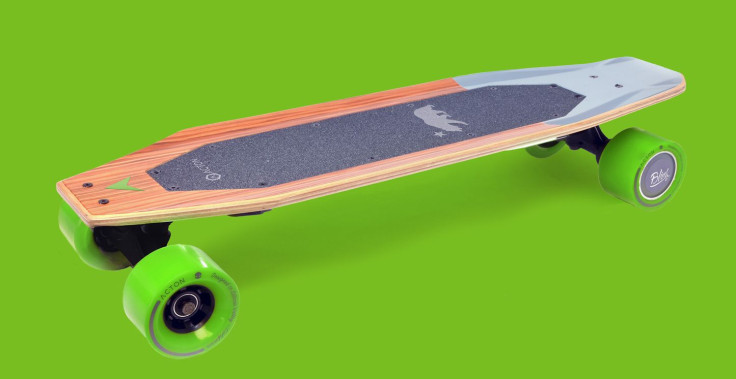I last tested Acton's sleek Blinkboard in March and raved its lightweight, sturdy design, its easy to use handheld remote and its convenient quick charging battery pack. At the time, the world was just getting over the latest balancing scooter fad, known as the hoverboard. Ultimately, recalls and bans meant the silly hoverboards went the way of its cheap batteries – up in flames.
But the Blinkboard is here to stay and Acton co-founder and CTO Peter Treadway recently visited iDigitalTimes again to show off two new skateboards the team has been working on: The production ready Acton Blink S and a prototype Blink S2.
DESIGN

The original Acton Blinkboard still looked like a conventional skateboard at first glance. But for the new line of electric boards, Acton wanted its boards to really stand out. This time, the Blink S and S2 features a more futuristic, polygon-shaped board design. Rather than a sheet of black grip tape across the top of the board, Acton only applied black grip tape on the center above the battery pack. The rest of the board surface is covered with a clear grip tape to show a classic maple finish across the board and a battleship matte grey finish on the tail. For extra structural rigidity, a piece of aircraft grade aluminum is sandwiched between the maple wood.
Underneath, the new Blink S and S2 both also feature the brand's iconic LED strip along the battery pack that made the original Blinkboard so cool to look at. The devils are in the details and I think Acton totally nailed a subtle and unique aesthetic.
HARDWARE


The Blink S features a Samsung Lithium ion battery pack that receives a full charge in just 45 minutes to provide power to a single hub motor, which provides a maximum range of 7 miles and a top speed of 15 mph. According to Treadway, the new hub motors are an important aspect to the new Blink S and S2's design.
The original Blinkboard was equipped with an electric motor integrated to the rear truck that propelled the skateboard via a belt to the rear wheel. However, Acton learned that many riders experienced unfavorable wear and tear due to the dirt that would catch on the belt. In this new design, the Blink S' motor is completely packaged within the hub of one of the rear wheels, creating a cleaner, more durable design that requires no maintenance.
The Blink S2 gets its name for squeezing two electric motors to drive both rear wheels and the electric motor's compact design led to significant packaging benefits that made the task pretty simple. The pair of electric motors combine for 1000 watts of power and effectively provides a range of 14 miles, which is doubles the 7 mile range in the standard Blink S. The S2 is also marginally faster, producing a top speed of 18 mph. However, the demands of the increased top speed and range meant the S2 needed a bigger battery pack, which also required Acton to increase the length of the Blink S2 to 31.5-inches, or 3.8-inches longer than the standard Blink S. Despite all the extra hardware, the Blink S2 still manages to weigh in at a relatively light 12 lbs. – 2 lbs. heavier than the standard Blink S. You can't go wrong – both the Blink S and Blink S2 are remarkably light for an electric skateboard.
ON THE STREETS

Overall, the boards definitely feel easier to ride this time around – the acceleration on the Blink S feels more progressive and it's a delight to never have to kick-push, especially when climbing an incline.
The remote for the Blink S and S2 are similar to the remote offered in the original Blinkboard – a thumb stick that propels the Blink S2 forward when pushed up and slows it down when pulled back. According to Treadway, minor changes to the remote's stick improved its smoothness in braking and acceleration. For the S2, braking and acceleration is further fine-tuned to manage the torque of two motors. What's more, the S2 remote has an additional battery warning indicator when the power is running low.
However, braking will still require some finesse as a panic stop could definitely cause a person to pull back on the toggle too quickly and throw a person off the board. On the other hand, over-cautiousness will cause longer braking distances, which would obviously suck if you run out of road. Perhaps this is something Acton will continue to calibrate before launch.
While ripping the Blinks at Battery Park, the fresh whip didn't go unnoticed – the design of the Blink S and S2 turned a lot of heads and caused at least one curious pedestrian to stop and ask a couple questions about the electric skateboard and ultimately appreciate its cool appeal.
VERDICT
Of the two, The Blink S is definitely the one I preferred more. It's easy to ride, lightweight and offers the better bang for the buck. The S2 has the benefit of a significantly longer range, but the S2's longer wheelbase doesn't necessarily make it any more stable than the standard S. What's more, the extra 3 mph top speed is negligible. What isn't negligible, however, is the price. The standard Blink S retails for $699 while the S2 demands $999, a $300 premium.
So will the multitude of people that usually take the bus or put on running shoes to walk around the neighborhood immediately bring home an Acton Blink S and embrace a new way to get around? Well, probably not. Skateboarding isn't mainstream and electric skateboarding is less so, at least for now.
Instead, the Acton Blink S and S2 are really high-quality products that are better catered to a niche type of buyer that are young, or young at heart, and looking for a hip way to get around and will pay a little extra for the added convenience of electric motors to avoid breaking a sweat.
The Acton Blink S and S2 aren't for everyone, but for some, there is no substitute. The Acton Blink S is available now, while the S2 will ship early 2017.

















